Discover 6 hidden attractions, cool sights, and unusual things to do in Lake Clark National Park and Preserve (United States). Don't miss out on these must-see attractions: Mount Redoubt, Twin Lakes, and Chigmit Mountains. Also, be sure to include Aleutian Range in your itinerary.
Below, you can find the list of the most amazing places you should visit in Lake Clark National Park and Preserve (Alaska).
Table of Contents
Mount Redoubt
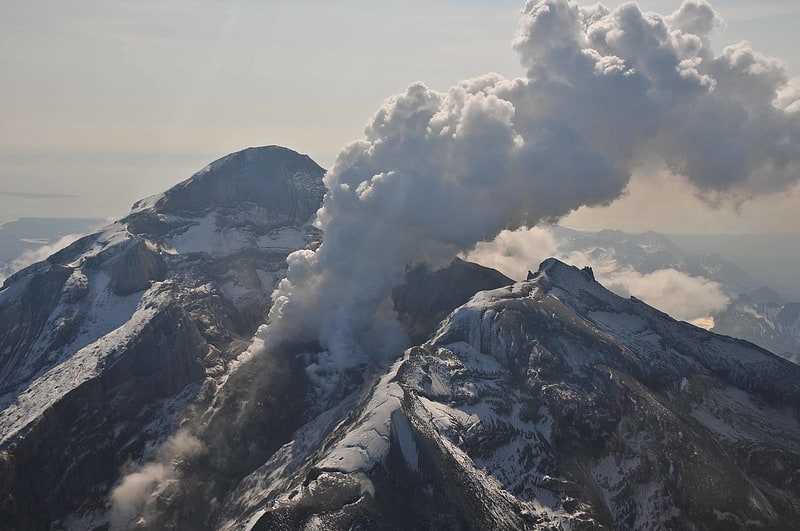
Stratovolcano in Alaska. Redoubt Volcano, or Mount Redoubt, is an active stratovolcano in the largely volcanic Aleutian Range of the U.S. state of Alaska. Located at the head of the Chigmit Mountains subrange in Lake Clark National Park and Preserve, the mountain is just west of Cook Inlet, in the Kenai Peninsula Borough about 110 miles southwest of Anchorage. At 10,197 feet, in just over 5 miles Mount Redoubt attains 9,150 feet of prominence over its surrounding terrain. It is the highest summit in the Aleutian Range. In 1976, Redoubt Volcano was designated as a National Natural Landmark by the National Park Service.
Active for millennia, Mount Redoubt has erupted four times since it was first observed: in 1902, 1966, 1989 and 2009, with two questionable eruptions in 1881 and 1933. The eruption in 1989 spewed volcanic ash to a height of 45,000 ft (13,700 m). It caught KLM Flight 867, a Boeing 747 aircraft, in its plume. After the plane descended 13,000 feet, the pilots restarted the engines and landed the plane safely at Anchorage. The ash blanketed an area of about 7,700 sq mi (20,000 km2). The 1989 eruption is also notable for being the first ever volcanic eruption to be successfully predicted by the method of long-period seismic events developed by Swiss/American volcanologist Bernard Chouet. As of August 2015, the Alaska Volcano Observatory has rated Redoubt as Aviation Alert Level Green and Volcano Alert Level Normal.[1]
Twin Lakes
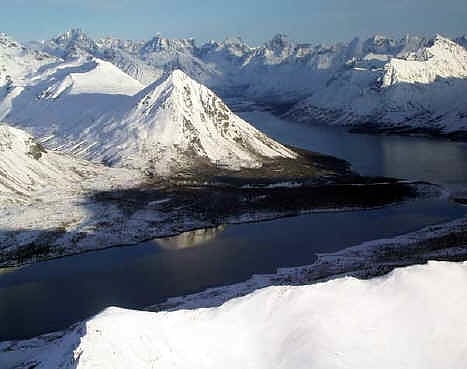
Lake in Alaska. Twin Lakes is a complex of two large lakes in Lake Clark National Park in the U.S. state of Alaska, near the northeast corner of Lake and Peninsula Borough. It contains a 6-mile-long upper lake and a smaller 4-mile-long lower lake, joined by a short connecting stream. The lakes outflow westward into the Chilikadrotna River. It is quite remote and unpopulated, except in the late summer as it is a popular hunting spot.
The lake complex was the retirement home of naturalist Richard Proenneke (1916–2003), who spent most (1968–1998) of the last 35 years of his life living there in a log cabin he built by hand. (See One Man's Wilderness: An Alaskan Odyssey and Alone in the Wilderness). It is only reachable by air taxi via a float or a wheel plane.[2]
Chigmit Mountains
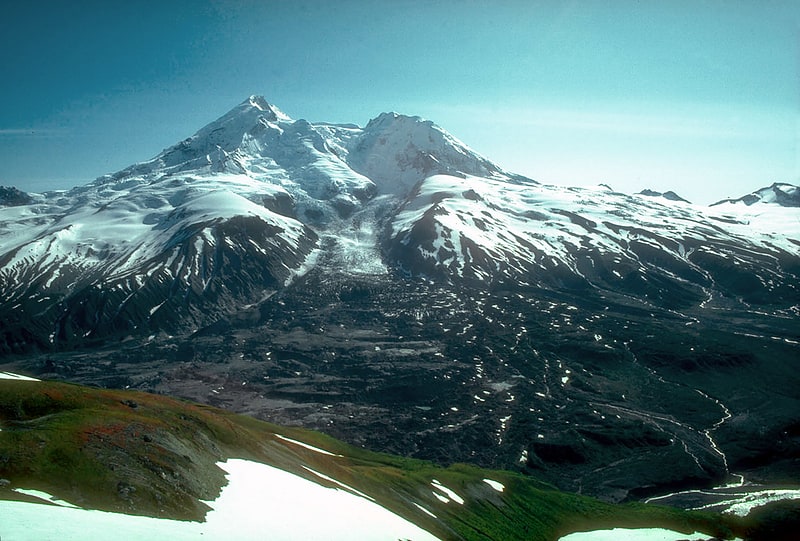
Mountain range in Alaska. The Chigmit Mountains are a subrange of the Aleutian Range in the Kenai Peninsula and Lake and Peninsula Boroughs of the U.S. state of Alaska.[3]
Aleutian Range
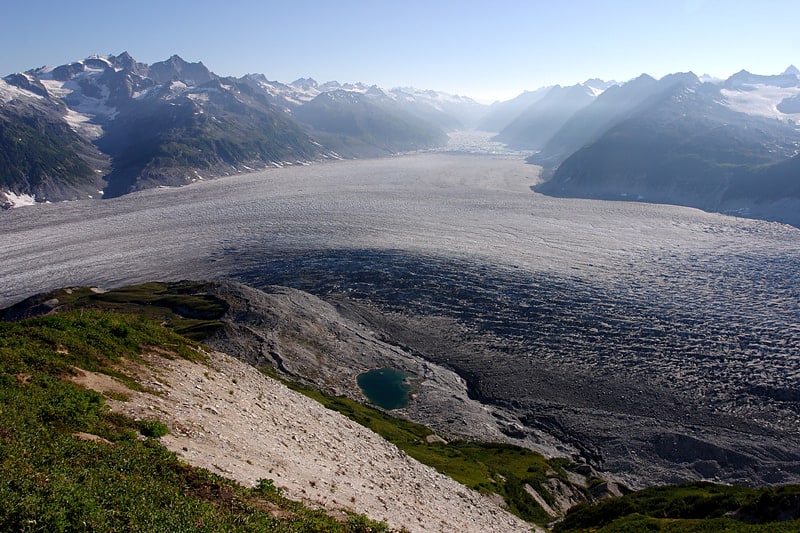
Mountain range in Alaska. The Aleutian Range is a major mountain range located in southwest Alaska. It extends from Chakachamna Lake to Unimak Island, which is at the tip of the Alaska Peninsula. It includes all of the mountains of the Peninsula. The Aleutian Range is special because of its large number of active volcanoes, which are also part of the larger Aleutian Arc. The mainland part of the range is about 600 miles long. The Aleutian Islands are a partially submerged western extension of the range that stretches for another 1,600 km. However the official designation "Aleutian Range" includes only the mainland peaks and the peaks on Unimak Island. The range is almost entirely roadless wilderness. Katmai National Park and Preserve, a large national park within the range, must be reached by boat or plane.
The core Aleutian Range can be divided into three mountain groups. Listed from southwest to northeast, they are:
- Mountains of the Alaska Peninsula and Unimak Island
- Chigmit Mountains
- Neacola Mountains
See Aleutian Islands for the continuation of the range to the west of Unimak Island. Just to the north of the Aleutian Range are the Tordrillo Mountains, the southeasternmost extent of the Alaska Range.
Selected mountains:
- Mount Redoubt (3,108 m), Chigmit Mountains
- Iliamna Volcano (3,054 m), Chigmit Mountains
- Mount Neacola, (2,873 m), Neacola Mountains
- Mount Shishaldin (2,857 m), Unimak Island
- Mount Pavlof (2,715 m), Alaska Peninsula
- Mount Veniaminof (2,508 m), Alaska Peninsula
- Isanotski Peaks (2,446 m), Unimak Island
- Mount Denison (2,318 m), Alaska Peninsula
- Mount Griggs, (2,317+ m), Alaska Peninsula
- Mount Douglas (2,153 m), Alaska Peninsula
- Mount Chiginagak (2,134 m), Alaska Peninsula
- Double Peak (2,078 m), Chigmit Mountains
- Mount Katmai (2,047 m), Alaska Peninsula
- Pogromni Volcano (2,002 m), Unimak Island
- Mount Okmok (1,073 m), Fox Islands
Mount Iliamna
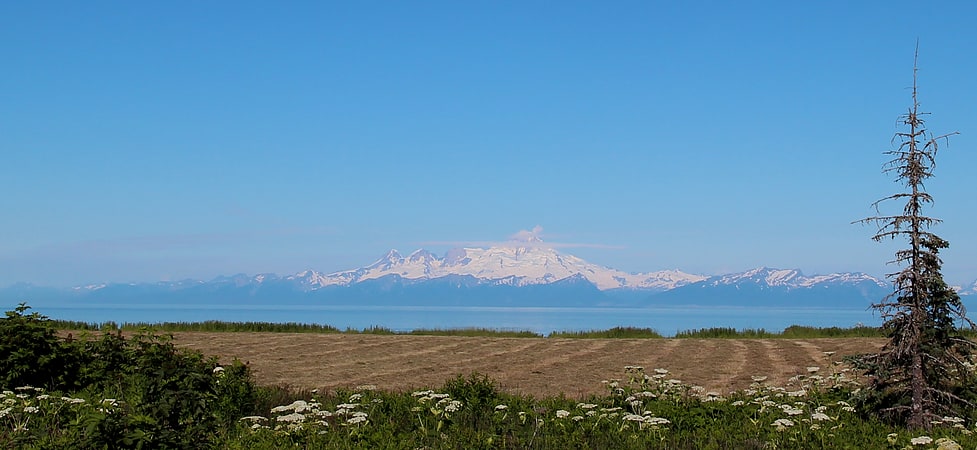
Stratovolcano in Alaska. Mount Iliamna is a glacier-covered stratovolcano in the largely volcanic Aleutian Range in southwest Alaska. Located in the Chigmit Mountain subrange in Lake Clark National Park and Preserve, the 10,016-foot volcano lies approximately 134 miles southwest of Anchorage on the west side of lower Cook Inlet. It is the 25th most prominent peak in the United States.
The volcano's glaciers have extensively altered its profile, cutting, deep and creating steep cliffs and cirques. A ridge extends 5 kilometres (3.1 mi) south from the main body of the mountain, with North Twin and South Twin peaks along its length. There is no summit crater, only a zone of fumaroles just south of the summit at the top of large collapse zone at the head of Red Glacier, which exposes a cross section of the mountain.
Holocene eruptive activity from Iliamna is little known, but radiocarbon dating seems to indicate at least a few eruptions, all before the European settlement of Alaska. Prehistoric eruptions have been dated to 5050 and 2050 BCE (VEI-4), 450 BCE and 1650. Historically observed eruptions took place in 1867 (VEI-2) and 1876 (VEI-3), with unconfirmed eruptions in 1933, 1947, 1952 and 1953. Fumaroles located at about 8,990 feet (2,740 m) elevation on the eastern flank produce nearly constant plumes of steam and minor amounts of sulfurous gases. These plumes are quite vigorous and have resulted in numerous pilot reports and early historical accounts of "eruptions" at Iliamna Volcano. Earthquake swarms and elevated seismicity and gas emissions were reported in 1996-97 and 2011–13. Iliamna was ranked as a high-threat volcano by the U.S. Geological Survey in 2005 and 2018. The 2018 assessment ranked Iliamna as the 20th most hazardous volcano in the United States, up from 22nd, with an aviation threat score of 34 and an overall score of 115, the second highest of the "high threat" category.
Major glaciers radiate from the summit of Iliamna, including Red Glacier, Tuxedni Glacier, Lateral Glacier and Umbrella Glacier.
Iliamna was first ascended in 1959. It was designated a National Natural Landmark in 1976.[5]
Neacola Mountains

Mountain range in Alaska. The Neacola Mountains are the northernmost subrange of the Aleutian Range in the U.S. state of Alaska. The range is named for the Neacola River which bounds it to the north and drains the highest and most rugged peaks of the group. They are bordered on the southeast by the Chigmit Mountains, another subrange of the Aleutian Range, on the northeast by the Tordrillo Mountains, and on the west and southwest by the lakes and lowlands of Lake Clark National Park and Preserve. The highest peak is Mount Neacola, 9,426 feet although the name is not officially recognized.
These mountains have not seen extensive exploration, due to their remoteness, typically poor weather, and lack of truly high peaks. However they are rugged and offer many climbing possibilities of an exploratory nature. Noted climber Fred Beckey visited the range in the early 1970s; in 1991, when he was "spiritual leader" of the expedition which made the first ascent of Mount Neacola; and again in 2004. Other recorded climbing visits occurred in 1979 and 1995.[6]